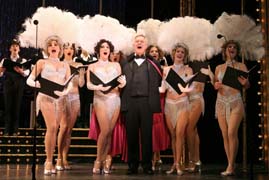
Paulanne Simmons
Encore Means Bravo in NY City Center's ''Face the Music''
''Face the Music''
Directed by John Rando
NY City Center
West 55th St. between 6th and 7th avenues
March 29 thru April 1, 2007
Reviewed by Paulanne Simmons March 31, 2007
In 1933, Irving Berlin and Moss Hart's ''Face the Music'' closed and was lost to the American public for 75 years. This season it has been revised in a ''concert version'' for NY City Center's Encore! series under the light-stepping direction of John Rando. It is a stunning theatrical experience that gives a glimpse of the glory that was once Broadway.
 |
| Photo by Joan Marcus. |
Coming up with a new script was not exactly an easy task. It was accomplished by using several existing scores, Moss Hart's handwritten copy of the script and lots of imagination. Only a few people now remember what the original production looked like. But Berlin's daughter, Mary Ellen, is one of them. And she says she is delighted with this revival.
''Face the Music'' is the kind of lighthearted, carefree musical that could only be written in the depth of the Great Depression. One can easily imagine how Berlin's exuberant music and Hart's sly wit lifted the spirits of all those who could afford the ticket price (a mere five dollars, later reduced).
The musical is about a producer, Hal Reisman (Walter Bobbie), who is desperate enough to use any devious means to finance his new musical, Rhinestones of '32. If this sounds a lot like Mel Brooks' ''The Producers,'' just remember that ''Face the Music'' came first.
The perfect backer turns out to be Martin Van Buren Meshbesher (Lee Wilkof), a policeman who has lots of illegally obtained money and a wife, Mrs. Myrtle Meshbesher (the imperial Judy Kaye) who supports his waste of money with shrill enthusiasm.
Meshbesher convinces his fellow cops to invest the contents of their ''tin boxes'' in the show before they get caught by the feds. When the police loose their money, Meshbesher turns to the banks, which of course end up bankrupt. So Meshbesher craftily adds the one thing sure to make a musical a success: sex. His scheme works stupendously until the vice squad arrives.
 |
| Photo by Joan Marcus. |
Hart's freewheeling plot presents numerous opportunities for parodies of all those evils we hold dear: police corruption, show business (Reisman intends to convincegullible bankers that it really is a business), theatrical conventions (actors keep asking each other if a line is a cue for a song or dance, and Felicia Finley's ''Torch Song'' would make Helen Morgan blush), and the Depression itself (''We'll give two cheers instead of three for the land of the brave and the free,'' the ensemble sings in an effort to encourage austerity).
Except for one scene in the Catskills where the cast escapes after the bust, ''Face the Music'' is set completely in and around Manhattan. Landmarks like the Automat, the Empire State Building and Bryant Park figure prominently, and scenic consultant John Lee Beatty knows how to suggest them with a minimum of scenery.
The term ''concert version'' is, of course, highly misleading when it comes to the polished sophistication of the Encore! series. True, the lavishly costumed actors carry the script, but they often put it down to sing, dance or make a point. In fact, the scripts seem to add to the refined theatricality of the show and work especially well in a show about a show such as ''Face the Music.''
 |
| Photo by Joan Marcus. |
''Face the Music'' has one song everyone knows, ''Let's Have Another Cup of Coffee,'' sung at the Automat, and lots of lesser known but equally memorable songs: ''Castles in Spain'' with it's Spanish rhythms, ''If You Have Faith'' with its Gospel overtones, and the innovative ''Manhattan Madness.''
Despite the extravaganzas on Broadway today, there's something about ''Face the Music'' that makes one say, ''They just don't make 'em like that anymore.
'' It's partly Bob Fisher's authentic and creative musical direction of Berlin's score and Randy Skinner's classy dance numbers. But it's also Hart and Berlin's unique combination of innocence and cynicism, the knowing nod combined with unbounded hope that makes this work so appealing.
During the Depression, men and women couldn't be bothered with the niceties of neurosis or experiments for the sake of the experimental. They were much more interested in survival and what makes it possible: laughter and joy.

| lobby | search
| home | cue-to-cue |
discounts | welcome | film
| dance | reviews |
| museums | NYTW
mail | recordings | coupons |
publications | classified |